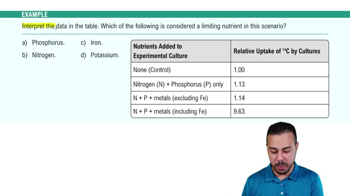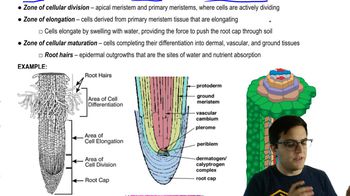Table of contents
- 1. Introduction to Biology2h 42m
- 2. Chemistry3h 40m
- 3. Water1h 26m
- 4. Biomolecules2h 23m
- 5. Cell Components2h 26m
- 6. The Membrane2h 31m
- 7. Energy and Metabolism2h 0m
- 8. Respiration2h 40m
- 9. Photosynthesis2h 49m
- 10. Cell Signaling59m
- 11. Cell Division2h 47m
- 12. Meiosis2h 0m
- 13. Mendelian Genetics4h 44m
- Introduction to Mendel's Experiments7m
- Genotype vs. Phenotype17m
- Punnett Squares13m
- Mendel's Experiments26m
- Mendel's Laws18m
- Monohybrid Crosses19m
- Test Crosses14m
- Dihybrid Crosses20m
- Punnett Square Probability26m
- Incomplete Dominance vs. Codominance20m
- Epistasis7m
- Non-Mendelian Genetics12m
- Pedigrees6m
- Autosomal Inheritance21m
- Sex-Linked Inheritance43m
- X-Inactivation9m
- 14. DNA Synthesis2h 27m
- 15. Gene Expression3h 20m
- 16. Regulation of Expression3h 31m
- Introduction to Regulation of Gene Expression13m
- Prokaryotic Gene Regulation via Operons27m
- The Lac Operon21m
- Glucose's Impact on Lac Operon25m
- The Trp Operon20m
- Review of the Lac Operon & Trp Operon11m
- Introduction to Eukaryotic Gene Regulation9m
- Eukaryotic Chromatin Modifications16m
- Eukaryotic Transcriptional Control22m
- Eukaryotic Post-Transcriptional Regulation28m
- Eukaryotic Post-Translational Regulation13m
- 17. Viruses37m
- 18. Biotechnology2h 58m
- 19. Genomics17m
- 20. Development1h 5m
- 21. Evolution3h 1m
- 22. Evolution of Populations3h 52m
- 23. Speciation1h 37m
- 24. History of Life on Earth2h 6m
- 25. Phylogeny2h 31m
- 26. Prokaryotes4h 59m
- 27. Protists1h 12m
- 28. Plants1h 22m
- 29. Fungi36m
- 30. Overview of Animals34m
- 31. Invertebrates1h 2m
- 32. Vertebrates50m
- 33. Plant Anatomy1h 3m
- 34. Vascular Plant Transport1h 2m
- 35. Soil37m
- 36. Plant Reproduction47m
- 37. Plant Sensation and Response1h 9m
- 38. Animal Form and Function1h 19m
- 39. Digestive System1h 10m
- 40. Circulatory System1h 57m
- 41. Immune System1h 12m
- 42. Osmoregulation and Excretion50m
- 43. Endocrine System1h 4m
- 44. Animal Reproduction1h 2m
- 45. Nervous System1h 55m
- 46. Sensory Systems46m
- 47. Muscle Systems23m
- 48. Ecology3h 11m
- Introduction to Ecology20m
- Biogeography14m
- Earth's Climate Patterns50m
- Introduction to Terrestrial Biomes10m
- Terrestrial Biomes: Near Equator13m
- Terrestrial Biomes: Temperate Regions10m
- Terrestrial Biomes: Northern Regions15m
- Introduction to Aquatic Biomes27m
- Freshwater Aquatic Biomes14m
- Marine Aquatic Biomes13m
- 49. Animal Behavior28m
- 50. Population Ecology3h 41m
- Introduction to Population Ecology28m
- Population Sampling Methods23m
- Life History12m
- Population Demography17m
- Factors Limiting Population Growth14m
- Introduction to Population Growth Models22m
- Linear Population Growth6m
- Exponential Population Growth29m
- Logistic Population Growth32m
- r/K Selection10m
- The Human Population22m
- 51. Community Ecology2h 46m
- Introduction to Community Ecology2m
- Introduction to Community Interactions9m
- Community Interactions: Competition (-/-)38m
- Community Interactions: Exploitation (+/-)23m
- Community Interactions: Mutualism (+/+) & Commensalism (+/0)9m
- Community Structure35m
- Community Dynamics26m
- Geographic Impact on Communities21m
- 52. Ecosystems2h 36m
- 53. Conservation Biology24m
33. Plant Anatomy
Growth
Problem 15e`
Textbook Question
Plants experience a vast array of conditions that can alter their growth and development, including temperature and availability of water, nutrients, and light. They are also exposed to pollutants such as acid rain formed largely as a result of burning fossil fuels and volcanic eruptions. Acid rain can strip minerals and nutrients from the soil and eat away the outer waxy layer of tissue that protects a plant. Acid rain is still a major environmental problem in certain regions. How does acid rain affect plant growth?
Based on the results presented here, predict the impact of acid rain on the vascular cambium in the two species.
How would that effect be apparent in the amount of wood produced in the tree trunks?
 Verified step by step guidance
Verified step by step guidance1
Understand the role of the vascular cambium: The vascular cambium is a layer of tissue in plants responsible for producing new cells that contribute to the growth of the plant's vascular system, including xylem and phloem. This growth is crucial for the plant's ability to transport water and nutrients.
Consider the impact of acid rain on soil nutrients: Acid rain can leach essential minerals and nutrients from the soil, which are vital for plant growth. A deficiency in these nutrients can hinder the function of the vascular cambium, affecting its ability to produce new cells.
Evaluate the effect on the protective waxy layer: Acid rain can damage the outer waxy layer of plant tissues, making them more susceptible to environmental stress and disease. This damage can further impact the vascular cambium by reducing the plant's overall health and ability to grow.
Predict the impact on wood production: If the vascular cambium is impaired due to nutrient loss and tissue damage, the production of new xylem cells (which contribute to wood formation) will be reduced. This would result in less wood being produced in the tree trunks over time.
Assess the long-term implications: Over time, reduced wood production can lead to weaker tree structures and potentially lower survival rates, especially in regions where acid rain is prevalent. This can have broader ecological impacts, affecting forest health and biodiversity.
 Verified video answer for a similar problem:
Verified video answer for a similar problem:This video solution was recommended by our tutors as helpful for the problem above
Video duration:
2mPlay a video:
Was this helpful?
Key Concepts
Here are the essential concepts you must grasp in order to answer the question correctly.
Acid Rain
Acid rain is precipitation with a lower pH than normal, caused by atmospheric pollution from sulfur dioxide and nitrogen oxides. These compounds originate from burning fossil fuels and volcanic eruptions, leading to the formation of sulfuric and nitric acids. Acid rain can leach essential nutrients from the soil and damage plant tissues, affecting growth and development.
Recommended video:
Guided course

Acids
Vascular Cambium
The vascular cambium is a layer of meristematic tissue in plants responsible for secondary growth, producing new xylem and phloem cells. It plays a crucial role in increasing the girth of stems and roots, contributing to the formation of wood in trees. Damage to the cambium, such as from acid rain, can impair its function, reducing wood production and affecting overall plant health.
Recommended video:
Guided course

Seedless Vascular Plants
Impact on Wood Production
Wood production in trees is largely dependent on the activity of the vascular cambium. Acid rain can disrupt the cambium's ability to produce new cells, leading to reduced growth and thinner tree trunks. This impact is evident in the decreased amount of wood produced, which can affect the structural integrity and ecological functions of trees in affected regions.
Recommended video:
Guided course

Factors Impacting Primary Production Example 1
Related Videos
Related Practice






















